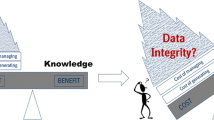Summary
Both society and industry are interested in increasing the safety of pharmaceuticals. Potentially dangerous compounds could be filtered out at early stages of R&D by computer prediction of biological activity and ADMET characteristics. Accuracy of such predictions strongly depends on the quality & quantity of information contained in a training set. Suggestion that some relevant chemical information can be added to such training sets without disclosing chemical structures was generated at the recent ACS Symposium. We presented arguments that such safety exchange of relevant chemical information is impossible. Any relevant information about chemical structures can be used for search of either a particular compound itself or its close analogues. Risk of identifying such structures is enough to prevent pharma industry from relevant chemical information exchange.
Similar content being viewed by others
References
http://www.cas.org
http://www.mdl.com/products/knowledge/crossfire_beilstein/
http://www.chemfinder.com
Bohacek R.S., McMartin C., Guida W.C., (1996) Med. Res. Rev. 16:3
Pirmohamed M., Park B.K.. (2001) Trends Pharm. Sci. 22:298
Poroikov V.V., Filimonov D.A.J., 2002 Comput. Aided Mol. Des. 16:819
Poroikov, V. and Filimonov, D. In Christoph Helma (Ed.), Predictive Toxicology, Taylor & Francis, 2005, pp. 459–478
Van de Waterbeemd H., De Groot M., 2003 Nat. Rev. Drug. Discov. 2:192
Safe exchange of chemical information: can relevant chemical information be exchanged without disclosing chemical structures. Symposium in the framework of 229th␣National Spring ACS Meeting, San Diego, CA (March 13–17, 2005)
http://www.mdl.com
Filimonov D., Poroikov V., Borodina Yu., Gloriozova T., (1999) J. Chem. Inf. Comput. Sci. 39:666
http://cactus.nci.nih.gov
Sadowski J., (1997) J. Comput. Aided. Mol. Des. 11:53
Baurin N., Mozziconacci J.-C., Arnoult E., Chavatte P., Marot C., Morin-Allory L., (1997) J. Chem. Inf. Comput. Sci. 44:276
Fang X., Shao L., Zhang H., Wang S., (1997) J. Chem. Inf. Comput. Sci. 44:249
http://www.prestwickchemical.com
Poroikov V.V., Filimonov D.A., Ihlenfeldt W.-D., Gloriozova T.A., Lagunin A.A., Borodina Yu.V., Stepanchikova A.V., Nicklaus M.C., 2003 J. Chem. Inform. Comput. Sci. 43:228
Schneier, B. Secrets and Lies: Digital Security in a Networked World. John Wiley & Sons, 2000, p. 432
Author information
Authors and Affiliations
Corresponding author
Rights and permissions
About this article
Cite this article
Filimonov, D., Poroikov, V. Why relevant chemical information cannot be exchanged without disclosing structures. J Comput Aided Mol Des 19, 705–713 (2005). https://doi.org/10.1007/s10822-005-9014-2
Received:
Accepted:
Published:
Issue Date:
DOI: https://doi.org/10.1007/s10822-005-9014-2




